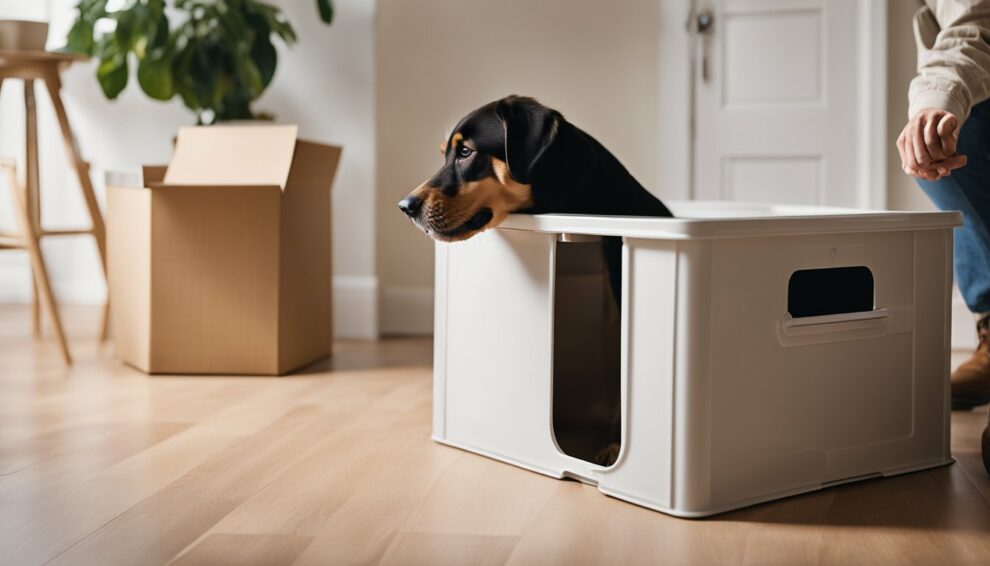Litter box training a dog is becoming an increasingly popular solution for pet owners seeking a convenient and controlled method for managing their canine companions’ bathroom needs.
Unlike the traditional notion that litter boxes are solely for cats, many small dog owners are discovering the benefits of this potty training method.
By teaching dogs to use a litter box, owners can offer their pets an accessible indoor restroom, which can be particularly advantageous for those living in apartments or in areas with harsh weather conditions.

The pros and cons of litter box training are varied and dependent on individual circumstances.
The positives include the elimination of outdoor bathroom breaks during inclement weather and the convenience for pet owners with mobility issues or those who work long hours and can’t always take their dog outside.
On the other hand, some of the challenges may include the suitability of litter box training mainly for smaller breeds due to size constraints and the necessity of consistent cleaning to manage odors and maintain hygiene.
Whether an owner is considering litter box training for a puppy or an older dog, the decision to adopt this method requires a thoughtful consideration of the unique lifestyle, living arrangements, and the specific needs of their pet.
Transitioning to this form of training involves a significant amount of patience and consistency from the owner, but it can facilitate a harmonious living environment and offer a flexible solution for a dog’s bathroom habits.
Understanding Litter Box Training

Litter box training for dogs offers an indoor solution for pet bathroom needs, balancing convenience with specific considerations.
This training method is not just for cats; many dog owners find it suitable for small breeds, senior pets, or those living in high-rise buildings.
Essentials of Litter Box Training
The foundation of litter box training leans on consistency, patience, and positive reinforcement.
Pet owners should start by placing their dog in the litter box after meals, naps, and periods of play.
Since dogs are creatures of habit, sticking to a routine is crucial for successful litter box training.
Choosing the Right Litter Box
When selecting a dog litter box, size is a key factor—larger breeds will require more space than small dogs.
The litter box should be easily accessible and placed in a quiet, convenient location. Some examples of dog litter boxes include:
- Standard Litter Pans: Simple, open boxes that can be suitable for small to medium dogs.
- Covered Litter Boxes: These provide privacy and help contain any mess and odors.
It’s essential that the litter box feels safe and secure for the dog to encourage consistent use.
Appropriate Litter Types
There are different types of litters available, and choosing the right one can make all the difference.
Options for dog litter include:
- Pelleted Litter: Often made from recycled paper or corn, this type can be easier on a dog’s paws.
- Clumping Litter: Similar to cat litter, it’s designed to make cleanup simpler by forming solid clumps as it absorbs liquid.
However, some dogs may prefer non-clumping litters, which are more akin to the feel of natural soil.
The choice of litter will depend on a dog’s personal preferences, any potential allergies, and the owner’s ability to clean and maintain the litter box environment.
Pros of Litter Box Training

Training a dog to use a litter box can be a quite beneficial arrangement, particularly for those living in apartments or have limited outdoor space.
This approach introduces a convenient solution for both dog owners and their pets, accommodating special needs for easier management.
Convenience for Dog Owners
One of the most significant benefits of litter box training is the convenience it provides.
Dog owners no longer face the urgency of late night or early morning walks, as their pets can comfortably use the litter box at any time.
This is especially advantageous for those with busy schedules or limited access to outdoor spaces.
Moreover, proper odor control methods can be employed within the litter box setup to maintain a fresh environment.
Benefits for Dogs with Special Needs
For senior dogs or those with mobility issues, the accessibility of an indoor litter box can be immensely helpful.
It reduces the strain of frequent trips outside and gives these dogs the opportunity to relieve themselves without the added pressure on their joints or the discomfort that comes with age-related conditions.
Advantages for Living in Apartments
Apartment living often comes with the reality of limited outdoor space, making litter box training a practical solution.
For residents of high-rise buildings, it can be logistically challenging to provide timely bathroom breaks.
Litter box training can offer a sense of relief for both the small dogs and their owners, mitigating the inconvenience of navigating down multiple floors for every potty excursion.
Cons of Litter Box Training

While litter box training offers convenience, it also comes with its own set of drawbacks that pet owners should consider.
Potential Challenges
Litter box training a dog may not always go smoothly, as consistency is harder to achieve compared to traditional housebreaking.
Despite a pet owner’s best efforts, dogs can be resistant to using the litter box, leading to accidents around the home.
Moreover, some dogs may not instinctively understand how to use a litter box, making the training process more time-consuming and frustrating for both the dog and owner.
Hygiene Concerns
Maintaining hygiene is a significant concern in litter box training.
Without regular cleaning, a litter box can become a source of odor and harmful bacteria.
Dogs, unlike cats, are also more likely to track litter and waste outside the box, increasing the mess around the house.
Additionally, some dogs can develop the habit of coprophagic behavior, which entails eating feces, and having waste accessible in a litter box can exacerbate this issue.
Behavioral Considerations
The introduction of a litter box may also inadvertently encourage unwanted behavioral issues.
Dogs may begin to associate any box-like space with an appropriate place to relieve themselves.
This can lead to them eliminating in inappropriate areas such as children’s sandboxes or laundry baskets.
Behavioral consistency is essential for successful training, yet the presence of a litter box can blur the lines of acceptable elimination areas for dogs.
Training Strategies

When embarking on the journey of litter box training a dog, the key to success lies in consistent application of strategies that cater to a dog’s natural instincts and learning patterns.
This section explores tailored techniques designed to make this training process as seamless as possible.
Positive Reinforcement Techniques
In the realm of litter box training, it’s crucial to leverage positive reinforcement.
This involves rewarding a dog promptly when they use the litter box correctly.
Rewards can take the form of treats, praise, or playtime, which helps the dog associate the litter box with a positive experience.
House training an adult dog or a puppy using positive reinforcement fosters good potty habits through a rewarding system.
Transition from Traditional Training
For those dogs previously trained to eliminate outdoors, transitioning them to a litter box requires some adaptation.
One should start by placing the litter box in an area where the dog is accustomed to going, and then gradually moving it to the desired permanent location.
Owners should maintain regular feeding schedules to predict potty times and guide their dogs to the litter box, reinforcing the new habit.
Overcoming Resistance
Not all dogs immediately take to a litter box, and in these cases, patience is paramount.
If a dog shows resistance, it’s important to not punish them, as negative reactions can lead to anxiety and avoidance.
Instead, ensure the litter box is inviting, considering size and location, and praise any interest or interaction with the box.
Persistence and positive reinforcement are key, as is providing a quiet and private space for the dog to do their business.
Incorporating these tips helps ease an adult dog into the new potty training routine.
Health and Maintenance
Litter box training a dog brings with it an array of health and maintenance considerations.
Owners should maintain high standards of cleanliness to prevent odors and must be cognizant of their dog’s health, watching for signs that may necessitate a visit to the veterinarian.
Managing Odors and Cleanliness
Cleanliness is crucial when a dog uses a litter box.
Regular cleaning of the litter box is essential to manage odor and maintain good hygiene.
They should scoop solid waste daily and replace the litter material as recommended by the type.
Some tips for odor management from experts include using absorbent litter that traps odors and cleaning the litter box with pet-safe disinfectants.
- Daily: Scoop solid waste.
- Regularly: Completely change litter material.
- Consistently: Clean the area around the litter box.
Adhering to a routine will significantly decrease the chance of foul smells infiltrating the home.
Health Considerations
A dog’s health can be influenced by how well their litter box routine is managed.
Owners should monitor their dog for any signs of injury or discomfort that might arise from using a litter box, especially if the dog is not willingly using the box or is having trouble accessing it.
Regular checks to ensure that the dog is properly vaccinated and is free from parasites, which can be contracted from soiled litter, are important to maintain their overall health.
A clean litter box will also reduce the risk of urinary tract infections.
If there’s any indication of health issues, such as a change in the dog’s elimination habits, they should contact their veterinarian.
- Monitor: Check for signs of discomfort or injury.
- Vaccinate: Keep up with vaccination schedules.
- Parasite Control: Ensure regular treatments against parasites.
- Veterinary Check-ups: Schedule regular check-ups with a vet.
In cases where a dog has undergone surgery, the litter box’s cleanliness is even more imperative to prevent infections during the recovery period.















